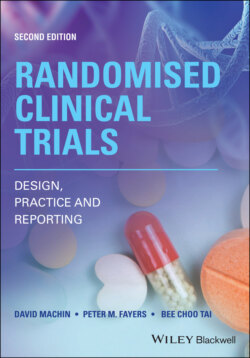Читать книгу Randomised Clinical Trials - David Machin - Страница 100
Example 3.13 Protocol PRESSURE (2000) Section 6.2: Pressure‐relieving support surfaces: a randomised evaluation 6.2 Exclusion criteria
ОглавлениеPatients will be excluded from the study if any of the following criteria apply. They:
– have pre‐existing Grade 3, 4 or 5 (Table 1a) pressure sore on admission
– have participated in this trial during a previous admission
– are an elective surgical patient with a planned post‐operative admission to ICU
– are an elective surgical patient admitted more than 4 days before surgery
– sleep at night in a chair
– weigh >22 stones/140 Kg (upper weight limit for overlay mattress)
a Table 1 referred to here is similar to that of Figure 4.2 in the next chapter.
In addition to the Exclusion Criteria, in the PRESSURE (2000) protocol, there were rather complex Inclusion Criteria as three general types of patients were to be included. These patients were those having an admission to one of the designated hospital wards, and who were also one of the following three types: (i) Acute, (ii) Elective with existing pressure sore or with reduced mobility, and (iii) Elective with neither a pressure sore nor with reduced mobility.
In the past, protocols tended to be restrictive about the patients admitted to trials and would focus on good‐prognosis patients. Modern trials increasingly adopt the perspective that patients are eligible provided the clinician regards all the options for treatment within the protocol as potentially suitable for the patient under consideration, and provided the clinician acknowledges that it is objectively unclear as to which option is preferable. Thus, fewer eligibility criteria now specify an upper age limit, but are more likely to emphasise that the patient should be fit enough to tolerate side effects and toxicity.
